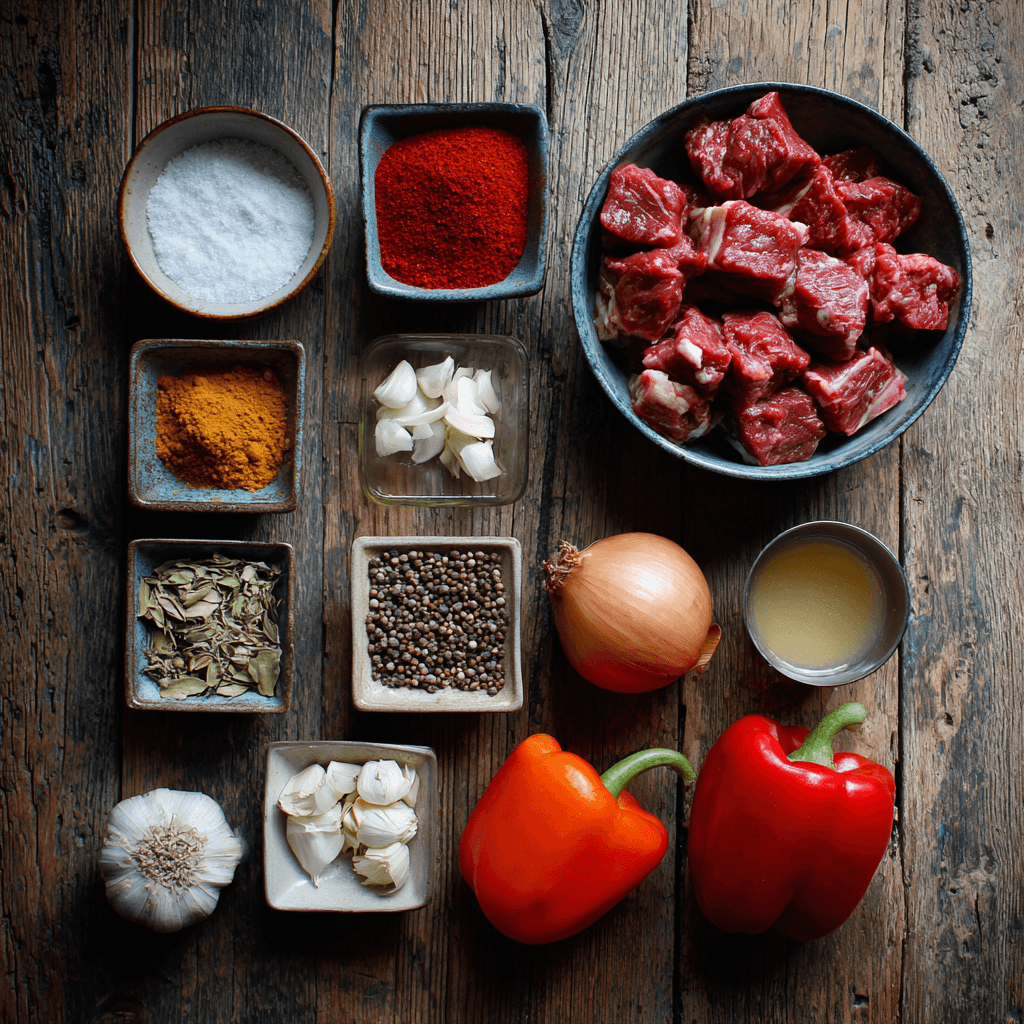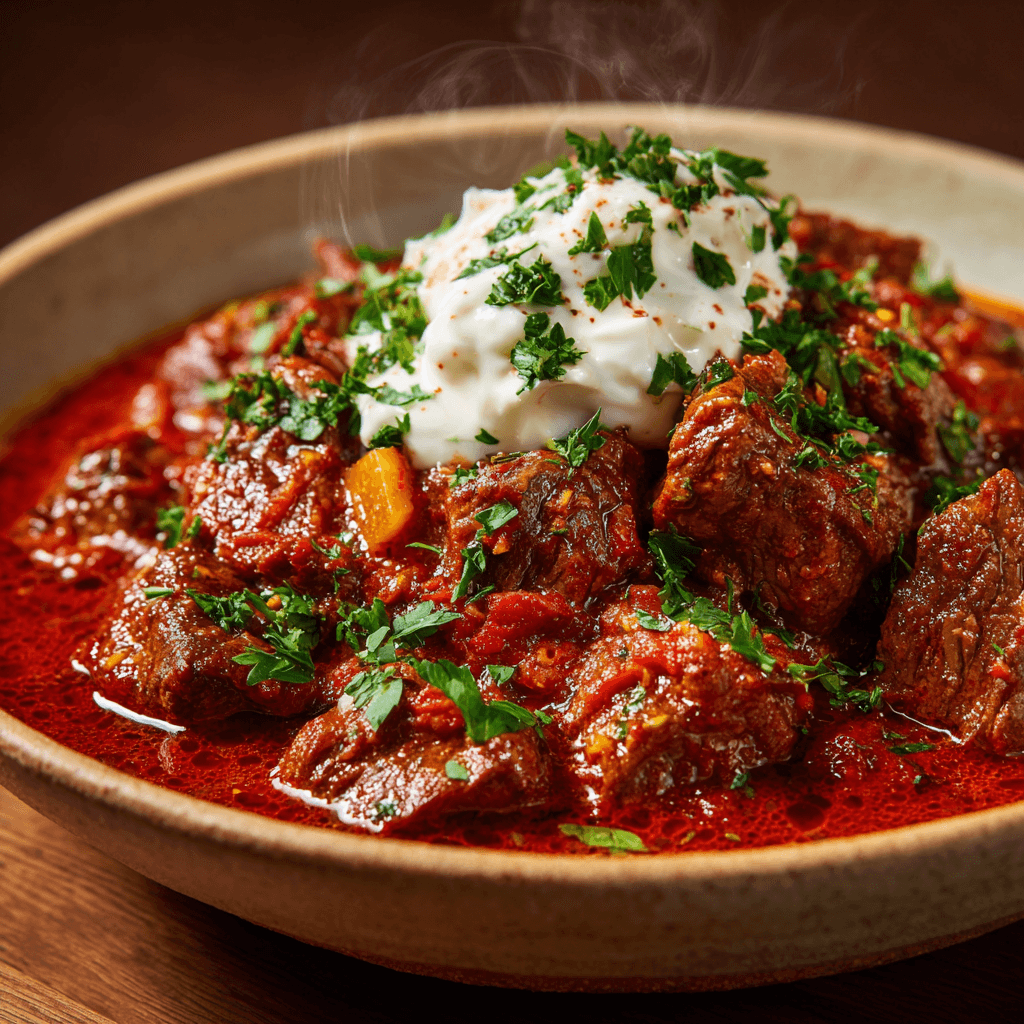Table of Contents
Gordon Ramsay Hungarian Goulash transforms humble beef into something extraordinary through precise technique and understanding. After years of feeding hungry firefighters at the station, I’ve learned that this iconic dish separates good cooks from great ones. The difference lies not just in the ingredients, but in respecting the slow-cooking process that breaks down tough connective tissue into silky, fork-tender perfection. According to the USDA guidelines on meat cookery, proper low-temperature braising ensures both safety and optimal texture. When I first attempted Gordon Ramsay Hungarian Goulash years ago, I rushed the process and ended up with chewy, disappointing results. Now I understand that patience and proper technique create the rich, paprika-scented masterpiece that defines authentic Hungarian cuisine. This comfort food approach mirrors the careful attention needed for other traditional recipes.
Why This Gordon Ramsay Hungarian Goulash Recipe Works (And Where Most Go Wrong)
The magic of Gordon Ramsay Hungarian Goulash lies in three fundamental principles that most home cooks overlook. First, the paprika must be bloomed in fat to release its full flavor potential – simply stirring it into liquid creates a muddy, bitter taste instead of the sweet, smoky depth this dish demands. Second, the meat requires proper searing at high heat to develop the Maillard reaction, which creates complex flavors that can’t be achieved any other way.
The Critical Temperature Control
Third, maintaining consistent low heat throughout the braising process ensures collagen breaks down into gelatin without overcooking the muscle fibers. According to food science research on braising techniques, temperatures between 275-300°F create optimal conditions for this transformation. Most people crank up the heat thinking it will cook faster, but this approach produces tough, stringy meat that no amount of cooking time can fix.
Ingredients That Actually Matter for Gordon Ramsay Hungarian Goulash

Hungarian paprika stands as the soul of Gordon Ramsay Hungarian Goulash, and quality here makes or breaks the entire dish. Look for sweet Hungarian paprika with a vibrant red color and rich aroma – avoid generic grocery store paprika powder that tastes like cardboard. The beef chuck roast provides the perfect balance of meat and marbling, with enough connective tissue to create body without excessive fat.
Caraway seeds add the distinctive earthy note that separates authentic Hungarian goulash from American versions, while tomato paste contributes umami depth and helps thicken the sauce naturally. Yellow onions should be large and firm, as they’ll cook down significantly and provide the sweet base layer. Beef stock must be low-sodium to control seasoning, and red wine adds acidity that helps tenderize the meat. Don’t substitute cooking wine – use something you’d actually drink, as the flavor concentrates during cooking. This attention to ingredient quality mirrors the precision needed in other foundational recipes.
Step-by-Step Instructions for Gordon Ramsay Hungarian Goulash
Preparation Phase
Cut 3 pounds of beef chuck roast into 2-inch cubes, removing excess fat but leaving some marbling for flavor. Season generously with kosher salt and black pepper 30 minutes before cooking to allow proper penetration. **Always pat meat completely dry before searing to prevent dangerous oil splattering.** Heat 2 tablespoons of vegetable oil in a heavy Dutch oven over medium-high heat until it shimmers but doesn’t smoke.
Building the Flavor Base
Sear beef cubes in batches, never overcrowding the pan, until deeply browned on all sides – about 8-10 minutes total per batch. **Use tongs instead of a fork to avoid piercing the meat and losing precious juices.** Remove beef and set aside. Reduce heat to medium and add 3 diced large onions to the same pot, scraping up browned bits. Cook until softened and lightly caramelized, approximately 8 minutes.
The Critical Paprika Step
Remove pot from heat temporarily and stir in 3 tablespoons of Hungarian paprika, 1 tablespoon tomato paste, and 1 teaspoon caraway seeds. **Never add paprika to a hot pan as it burns instantly and becomes bitter – this is the most common mistake that ruins Gordon Ramsay Hungarian Goulash.** Return to low heat and cook for 30 seconds until fragrant. Add 1 cup red wine and scrape up any remaining fond.
The Long Simmer
Return beef to pot along with 4 cups beef stock, ensuring liquid barely covers the meat. Bring to a gentle simmer, then reduce heat to low. **Maintain temperature between 275-300°F – vigorous boiling will toughen the meat beyond repair.** Cover and simmer for 2-2.5 hours until beef shreds easily with a fork. Add 3 diced potatoes in the final 45 minutes. This slow-cooking approach requires the same patience as other comfort food classics. For more detailed braising techniques, consult professional culinary resources on braising fundamentals.
Pro-Tips That Change the Game
- Toast whole caraway seeds in a dry pan for 30 seconds before grinding – this intensifies their flavor dramatically and adds authentic Hungarian character
- Save pasta water when serving over egg noodles – the starch helps bind the sauce and creates restaurant-quality presentation
- Let the Gordon Ramsay Hungarian Goulash rest for 15 minutes before serving to allow flavors to meld and sauce to thicken naturally
- Add a dollop of sour cream and fresh dill just before serving, but never stir it in – the visual contrast and temperature difference enhance the eating experience
- Use a wooden spoon to scrape fond from the pot bottom – metal utensils can damage your Dutch oven and miss those crucial flavor bits
- Check liquid levels every 45 minutes during cooking and add warm stock if needed to prevent scorching
Storage & Leftovers for Gordon Ramsay Hungarian Goulash
Gordon Ramsay Hungarian Goulash actually improves with time as flavors continue developing overnight. Store in refrigerator for up to 4 days in airtight containers, ensuring the temperature stays below 40°F for food safety. The sauce will thicken considerably when cold, which is completely normal.
For reheating, add a splash of beef stock or water and warm gently over low heat, stirring occasionally to prevent sticking. **Never reheat in the microwave at full power as this creates hot spots that can burn your mouth and unevenly heated food.** The dish freezes well for up to 3 months, though potatoes may become slightly grainy after thawing. According to FDA safe food handling guidelines, always cool completely before refrigerating and reheat to 165°F internal temperature.

Gordon Ramsay Hungarian Goulash
Ingredients
Equipment
Method
- 1️⃣ Cut beef chuck roast into 2-inch cubes, removing excess fat but leaving marbling. Season generously with kosher salt and black pepper. Let sit for 30 minutes to allow seasoning to penetrate.
- 2️⃣ Pat meat completely dry with paper towels. Heat vegetable oil in heavy Dutch oven over medium-high heat until shimmering but not smoking.
- 3️⃣ Sear beef cubes in batches without overcrowding, using tongs to turn until deeply browned on all sides (8-10 minutes per batch). Remove beef and set aside.
- 4️⃣ Reduce heat to medium. Add diced onions to same pot, scraping up browned bits. Cook until softened and lightly caramelized, about 8 minutes.
- 5️⃣ Remove pot from heat temporarily. Stir in Hungarian paprika, tomato paste, and caraway seeds. Return to low heat and cook for 30 seconds until fragrant.
- 6️⃣ Add red wine and scrape up remaining fond from pot bottom. Return beef to pot along with beef stock, ensuring liquid barely covers meat.
- 7️⃣ Bring to gentle simmer, then reduce heat to low. Maintain temperature between 275-300°F. Cover and simmer for 1 hour and 15 minutes.
- 8️⃣ Add diced potatoes and continue simmering covered for final 45 minutes until beef shreds easily with fork and potatoes are tender.
- 9️⃣ Let rest for 15 minutes before serving to allow flavors to meld and sauce to thicken naturally. Serve with dollop of sour cream and fresh dill.
Nutrition
Notes
Tried this recipe?
Let us know how it was!Frequently Asked Questions About Gordon Ramsay Hungarian Goulash
What’s the difference between regular goulash and Hungarian goulash?
Hungarian goulash is a soup-like stew featuring beef, onions, and generous amounts of paprika, traditionally served with bread. American “goulash” typically contains ground beef, pasta, and tomatoes – essentially a different dish entirely. Authentic Gordon Ramsay Hungarian Goulash focuses on slow-braised beef chunks in a paprika-rich sauce, staying true to the original Magyar recipe that dates back centuries.
What is the best cut of meat for Hungarian goulash?
Chuck roast provides the ideal combination of flavor and texture for Gordon Ramsay Hungarian Goulash. This well-marbled cut contains enough connective tissue to create body and richness when braised slowly. Avoid lean cuts like sirloin or tenderloin, which become dry and stringy. Short ribs work as an alternative but require longer cooking times and more careful fat removal.
Why is it called Hungarian goulash?
The name derives from “gulyás,” meaning cowherd in Hungarian, referring to the cattle herders who originally created this dish. These nomadic shepherds cooked beef in large cauldrons over open fires, using paprika as both flavoring and preservative. The dish evolved from a simple outdoor meal into a national treasure, representing Hungarian culinary identity worldwide.
What type of cooking technique is used to produce Hungarian goulash?
Braising forms the foundation of Gordon Ramsay Hungarian Goulash technique – combining initial high-heat searing with long, slow cooking in liquid. This method breaks down tough collagen into silky gelatin while developing complex flavors through the Maillard reaction. The two-stage process ensures both proper texture and rich taste that defines authentic goulash preparation.
This hearty dish brings families together around the table, just like it did for my firehouse crew during those long winter shifts. The time invested in proper technique pays dividends in flavor and satisfaction that lasts well beyond the meal itself. Perfect comfort food never goes out of style.
Stay safe,
Jack Sullivan


